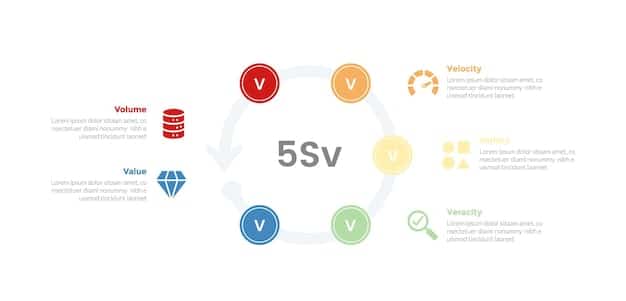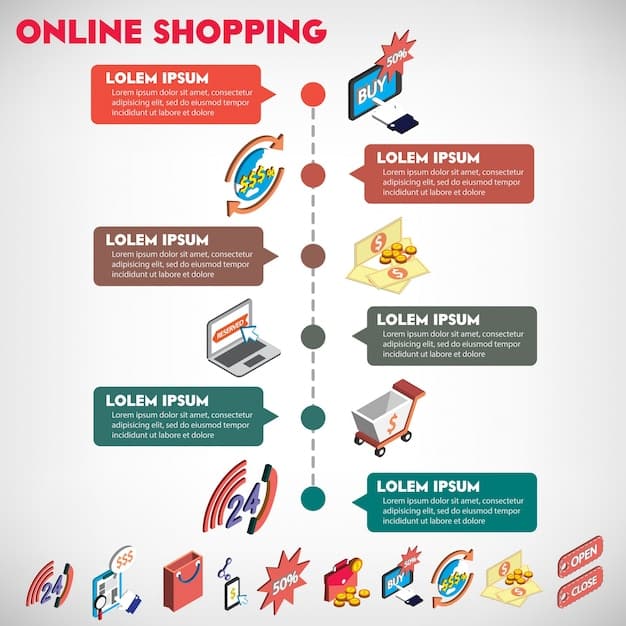PCI DSS 4.0: Key Changes for US E-commerce in 2025

PCI DSS 4.0: What US E-commerce Businesses Need to Know About the Updated Security Standards in 2025 overhauls data security for payments, emphasizing flexibility and risk-based approaches, vital for compliance by 2025.
Navigating the world of e-commerce security can feel like traversing a minefield. With cyber threats constantly evolving, staying ahead requires diligence and a deep understanding of the standards that protect your customers’ data. One such standard is the Payment Card Industry Data Security Standard (PCI DSS), and it’s undergoing a significant update.
Get ready for **PCI DSS 4.0: What US E-commerce Businesses Need to Know About the Updated Security Standards in 2025**. This isn’t just a minor tweak; it’s a comprehensive revision designed to address emerging threats and provide greater flexibility. So, what does this mean for your US-based e-commerce business, and how can you prepare for the 2025 deadline?
Understanding the Basics of PCI DSS 4.0
Before diving into the specifics, it’s crucial to grasp the fundamentals of PCI DSS. This standard is a set of security requirements for organizations that handle credit card information. It’s designed to protect cardholder data and reduce fraud.
What Exactly is PCI DSS?
PCI DSS stands for Payment Card Industry Data Security Standard. It’s not a law, but rather a contractual obligation imposed by the major credit card brands – Visa, Mastercard, American Express, Discover, and JCB. Compliance with PCI DSS demonstrates that your business is taking the necessary steps to protect sensitive data.
Why the Need for an Update?
The digital landscape is constantly evolving, and so are the tactics used by cybercriminals. PCI DSS 3.2.1, the previous version, was becoming outdated in the face of new threats. PCI DSS 4.0 addresses these emerging risks and provides a more adaptable framework for security.
- Addresses emerging threats like cloud-based attacks and sophisticated malware.
- Provides more flexibility to accommodate different business models and technologies.
- Strengthens authentication and access control requirements.
- Enhances focus on ongoing security monitoring and incident response.
In essence, understanding the basics of PCI DSS 4.0 involves recognizing its core purpose – protecting cardholder data – and appreciating the reasons behind the update. This groundwork sets the stage for exploring the specific changes and their implications for your e-commerce operation.

Key Changes in PCI DSS 4.0 for E-commerce Businesses
Now, let’s delve into the specific updates introduced by PCI DSS 4.0 that will significantly impact e-commerce businesses in the US. These changes span various aspects of data security, from authentication to encryption.
Stronger Authentication Requirements
One of the most significant changes is the emphasis on stronger authentication methods. Multi-factor authentication (MFA) is now a requirement for all personnel accessing the cardholder data environment (CDE). This adds an extra layer of security beyond just a username and password.
Enhanced Encryption Standards
PCI DSS 4.0 mandates the use of stronger encryption algorithms and protocols to protect cardholder data both in transit and at rest. Businesses need to ensure that they are using up-to-date encryption methods that meet the new standards.
Increased Flexibility and Customization
Unlike previous versions, PCI DSS 4.0 offers greater flexibility in how businesses can meet the security requirements. The standard allows for customized implementation of security controls based on a risk-based approach.
- Risk assessments are now even more critical to identify vulnerabilities.
- Businesses can implement compensating controls if they cannot meet a specific requirement.
- Documentation of security controls and processes is essential for demonstrating compliance.
These enhanced requirements in PCI DSS 4.0 necessitate a proactive approach to security. From implementing MFA to upgrading encryption, e-commerce businesses must adapt to these changes to ensure compliance and safeguard sensitive data. Understanding these key changes is the first step towards a secure and compliant future.
Preparing Your E-commerce Business for PCI DSS 4.0 Compliance
The 2025 deadline may seem distant, but preparing for PCI DSS 4.0 compliance requires a strategic and phased approach. Here’s a roadmap to guide you through the process.
Conduct a Thorough Gap Analysis
Start by assessing your current security posture and identifying any gaps between your existing controls and the new PCI DSS 4.0 requirements. This will provide a clear picture of the areas needing improvement.
Update Security Policies and Procedures
Review and update your security policies and procedures to align with the new standard. This includes documenting all security controls and processes, and ensuring that they are effectively implemented and maintained.
Implement Necessary Security Controls
Based on your gap analysis, implement the necessary security controls to meet the PCI DSS 4.0 requirements. This may involve upgrading hardware and software, implementing new authentication methods, and enhancing encryption standards.

Employee Training and Awareness
Security is not just about technology; it’s also about people. Provide comprehensive training to your employees on the new PCI DSS 4.0 requirements and their roles in maintaining security. Regular security awareness programs can help prevent human error and insider threats.
Regular Audits and Assessments
Conduct regular internal audits and external assessments to ensure ongoing compliance with PCI DSS 4.0. Address any identified vulnerabilities promptly and maintain a proactive approach to security.
- Designate a PCI DSS compliance officer.
- Implement a robust vulnerability management program.
- Use a Qualified Security Assessor (QSA) for guidance.
Proactive planning and execution are paramount. By conducting gap analyses, updating security policies, implementing controls, training employees, and performing regular audits, e-commerce businesses can navigate the path to PCI DSS 4.0 compliance successfully.
The Impact of Non-Compliance with PCI DSS 4.0
Failing to comply with PCI DSS 4.0 can have severe consequences for your e-commerce business, extending far beyond financial penalties.
Financial Penalties and Fines
The most immediate consequence of non-compliance is financial penalties. Credit card companies can impose fines ranging from thousands to hundreds of thousands of dollars, depending on the severity and duration of the violation.
Reputational Damage
A data breach resulting from non-compliance can severely damage your company’s reputation. Customers may lose trust in your business, leading to a decline in sales and long-term damage to your brand.
Legal Repercussions
Non-compliance can also lead to legal repercussions, including lawsuits from affected customers and regulatory investigations. The costs associated with legal defense and settlements can be substantial.
Compliance with standards like **PCI DSS 4.0: What US E-commerce Businesses Need to Know About the Updated Security Standards in 2025** should not be seen as optional. Companies that take security seriously signal commitment to ethical standards to their customers.
Business Disruption
In the event of a data breach, your business may face significant disruption. You may need to suspend operations to investigate the breach, implement corrective measures, and notify affected parties.
Loss of Merchant Account
Credit card companies may terminate your merchant account if you fail to comply with PCI DSS 4.0. This means you will no longer be able to accept credit card payments, which can cripple your e-commerce business.
Strategies for Maintaining Ongoing PCI DSS 4.0 Compliance
Achieving PCI DSS 4.0 compliance is not a one-time event; it’s an ongoing process that requires continuous monitoring, assessment, and improvement. Businesses need strategies to maintain compliance over time.
Implement a Continuous Monitoring Program
Establish a program for continuous monitoring of your security controls and environment. This includes regular vulnerability scans, penetration testing, and security log analysis.
Stay Updated with Threat Intelligence
Keep abreast of the latest cyber threats and vulnerabilities by subscribing to threat intelligence feeds and participating in industry forums. This will help you proactively identify and address potential risks.
Regularly Review and Update Security Policies
Security policies and procedures should be reviewed and updated regularly to reflect changes in your business environment, technology landscape, and threat landscape. This ensures that your security controls remain effective.
Maintaining **PCI DSS 4.0: What US E-commerce Businesses Need to Know About the Updated Security Standards in 2025** should be a constant focus for US e-commerce businesses.
Conduct Regular Internal Audits
Perform regular internal audits to assess the effectiveness of your security controls and identify any weaknesses. This will help you proactively address issues before they lead to compliance violations.
Engage with Security Experts
Consider engaging with security experts and consultants to provide ongoing guidance and support with your PCI DSS 4.0 compliance efforts. They can help you navigate the complexities of the standard and implement best practices.
To recap, the update to **PCI DSS 4.0: What US E-commerce Businesses Need to Know About the Updated Security Standards in 2025** is a crucial topic.
| Key Point | Brief Description |
|---|---|
| 🔑 MFA Implementation | Multi-factor authentication is now required for all personnel accessing cardholder data. |
| 🛡️ Enhanced Encryption | Stronger encryption algorithms must be used to protect cardholder data. |
| 📊 Risk Assessments | Regular risk assessments are crucial for identifying vulnerabilities. |
| 🧑💻 Employee Training | Proper training is critical for employees to understand and follow security protocols. |
Frequently Asked Questions (FAQ)
The deadline for full compliance with PCI DSS 4.0 is March 31, 2025. US e-commerce businesses should assess their current security measures and plan for necessary updates to meet this deadline.
The primary goals include addressing emerging threats, adding flexibility to address different business models, strengthening authentication and access controls, and increasing focus on ongoing security monitoring and incident response.
Even small businesses must comply with **PCI DSS 4.0: What US E-commerce Businesses Need to Know About the Updated Security Standards in 2025**. The updated standard provides some flexibility, but all businesses must ensure they are protecting cardholder data effectively.
Multi-factor authentication requires users to provide multiple verification factors to gain access. It’s important because it adds an extra layer of security, making it more difficult for unauthorized users to access sensitive data.
You can find detailed information about **PCI DSS 4.0: What US E-commerce Businesses Need to Know About the Updated Security Standards in 2025** on the PCI Security Standards Council website, which is the official source for all PCI DSS documentation.
Conclusion
Preparing for **PCI DSS 4.0: What US E-commerce Businesses Need to Know About the Updated Security Standards in 2025** is not merely a compliance exercise but a crucial step in safeguarding your business and customers in an evolving digital landscape. By staying proactive and informed, US e-commerce businesses can confidently navigate the transition and maintain a secure payment environment.
The forthcoming updates require attention to detail. Use this guide to stay ahead of the curve and protect your e-commerce business from potential threats. The effort is an imperative for those operating online stores.





